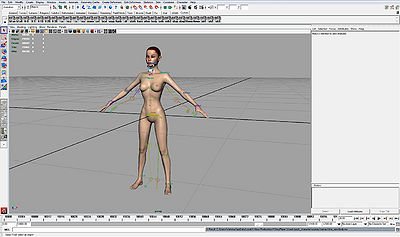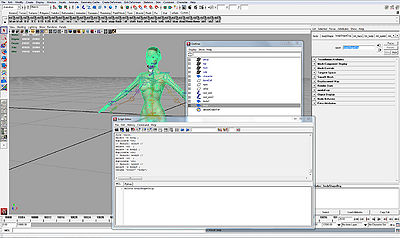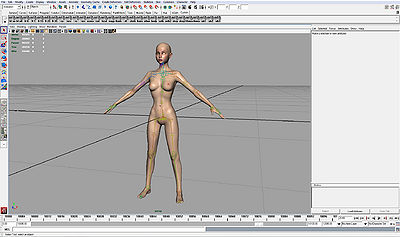Difference between revisions of "Deriving new character from template character"
From XStoryPlayer Wiki
| Line 1: | Line 1: | ||
In this tutorial we will be replacing the character template parts with a new character. | In this tutorial we will be replacing the character template parts with a new character. | ||
| − | After this tutorial you will know how to create a new character for [[XStoryPlayer]] | + | After this tutorial you will know how to create a new character for [[XStoryPlayer]]<br> |
| + | <br> | ||
| + | Tutorial pack will be updated later today!! | ||
<ol> | <ol> | ||
| Line 33: | Line 35: | ||
A good text editor for editing large files is: [http://www.textpad.com TextPad].<br> | A good text editor for editing large files is: [http://www.textpad.com TextPad].<br> | ||
Reopen the <code>body.ma</code> file in Maya. The weights should now be correct.</li> | Reopen the <code>body.ma</code> file in Maya. The weights should now be correct.</li> | ||
| + | <li>You can now delete the model body and its joints. Use the [[Filemaker]] to create the character</li> | ||
</ol> | </ol> | ||
Revision as of 14:59, 11 February 2015
In this tutorial we will be replacing the character template parts with a new character.
After this tutorial you will know how to create a new character for XStoryPlayer
Tutorial pack will be updated later today!!
- We assume that you have finished the 'Installing template character' tutorial successfully.
- So you have thepack_characterpack installed.
- You have the testing shortcut, for testing the character.
- Also your Maya project path is set to thepack_character - Open the
./pack/pack_character/sources/scenes/char_template/body.mafile in Maya.
Import themodel/body.mafrom the 'Tutorial resource pack' into your scene. This is the new (rigged) model you will use to replace the template character.
Save the new scene to./pack/pack_character/sources/scenes/char_new/body.ma.
Your end result should look like theStep 1 Char_new/body.mafile.

- Copy the
Step 1 Char_new/body.iniinto yourchar_newdirectory as well.
This is the template ini file, but most elements are commented out so they do not have to created at first. - Remove the hair, the collider, the old body etc to cleanup the scene.
Make sure there are no meshes binded to theroot_jointhierarchy.
Also make a copy of the new model body that is not rigged. Hide the rigged model body and the rig itself.
Your end result should look exactly like theStep 2 Char_new/body.mafile.

- Now that there are not meshes binded to the
root_jointhierarchy we can move/rotate the joints so the new model has correct joints.
Make sure you do not translate the joints too much. Better is to use the joint orient to position them.
Use 'X-Ray Joints' to view them better through the body. Use different views (top,front,side) to get a good view of the joint positions.
Use the original model joint hierarchy for reference on where to position the joints.
Do not rotate or move the root_joint! Move the body instead.
Adjust the joints and make the end result look like theStep 3 Char_new/body.mafile.

- Now bind the model body mesh to the root_joint hierarchy. Rotate the joints to check that the body is binded.
Now we have to fix the skinning by mapping the old model rig onto the new one. We can use the Filemaker for that.
Run theStep 4 Char_new/filemaker/start.iniusing the Filemaker, it will map the weights onto the new model.
After running anexport.txtfile is created. Open thebody.mafile in an text editor and replace the weights of the body with the exported weights.
To find where the weights in thebody.mafile are located, search for the skin cluster of the bodyShape e.g.skinCluster8.
A good text editor for editing large files is: TextPad.
Reopen thebody.mafile in Maya. The weights should now be correct. - You can now delete the model body and its joints. Use the Filemaker to create the character